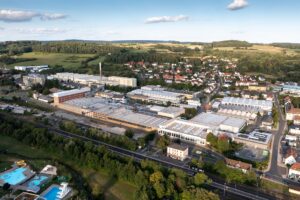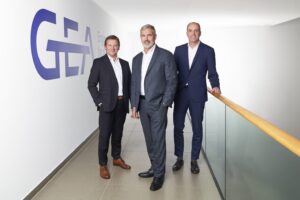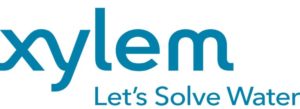Q2/2005 Merck Results
Thanks to innovative products such as our cancer treatment Erbitux and liquid crystals, Merck’s profitability continues to rise,” said Bernhard Scheuble, Chairman of the Executive Board of Merck KGaA. “Excluding the gains from our strategic divestments, Merck’s profit after tax rose a very substantial 27%. Excluding divested units, Merck continues to expect Group sales to rise by a single-digit rate in 2005.”
Q2/2005: Merck KGaA Profit After Tax, Before Exceptionals +27%
Merck Group sales rose by 8.6% to EUR 1,482 million in the second quarter, aided by good performances from the Ethicals, Generics and Liquid Crystals divisions. Excluding exceptional items, Merck’s profit after tax for the second quarter of 2005 increased 27% to EUR 123 million from EUR 96 million.
The operating result rose 15% to EUR 203 million. Return on sales (ROS: operating result/sales) increased to 13.7% from 12.9% while return on capital employed (ROCE) rose to 18.5% from 16.7%. Merck completed the sale of its Electronic Chemicals business to BASF AG of Ludwigshafen, Germany, on April 15. The sales price was EUR 270 million and Merck booked a gain of EUR 138.7 million.
Earnings before interest and tax (EBIT) decreased 34% to EUR 340 million from the year-ago figure of EUR 513 million, which included the one-time extraordinary gain of EUR 292.5 million on the divestment of VWR International. All profit figures for the second quarter of 2005 showed similar decreases in comparison to the year-ago quarter because of the gain from the disposal of VWR.
Profit before tax fell 35% to EUR 322 million from EUR 494 million the year before. Profit after tax decreased 31% to EUR 252 million from EUR 364 million. Merck’s underlying tax rate remained at a lower level, dropping to 33.4% in the second quarter of 2005 compared to 38.8% in the year-ago quarter.
Gains from the divestments of VWR International and the Biomet-Merck joint venture last year and the Electronic Chemicals business this year are having a positive effect. Merck’s financial result was reduced a further 4.3% in the second quarter to a very low EUR – 18 million.
The number of Merck employees worldwide decreased by 59 people, or 0.2%, to 28,606 (as of June 30).
Highlights
The impressive acceptance of Erbitux® by patients and doctors led to sales in the second quarter of EUR 52 million, a 22% increase compared to sales of EUR 42 million in the first quarter of 2005. Since its approval in the European Union just a year ago, Erbitux® has been approved in 39 countries in Merck’s marketing territory, with Hong Kong, South Korea, Colombia and Israel approving it during the second quarter of this year.
Sales by the Liquid Crystals division rose 9.9% to EUR 183 million in the second quarter compared to record sales of EUR 167 million in the year-ago quarter. Compared to the first quarter of 2005, sales were up 25%. R&D expenses, mainly for the new OLED business, jumped 77% to EUR 19 million. In addition, the start-up phase of the new production facilities in Darmstadt is taking longer than expected. As a result, the second-quarter operating result fell by 8.1% to EUR 78 million compared to the year-ago quarter. This was a 14% increase compared to the first quarter 2005 operating result of EUR 68 million.
Outlook
Merck expects Erbitux® sales to continue to grow as it gains approval in more countries. In addition, Merck plans to seek approval for Erbitux® for the treatment of head and neck cancer in the European Union yet this year, possibly as early as the third quarter.
The Liquid Crystals division’s operating result, as well as its ROS and ROCE, suffered in the second quarter from high R&D costs for the new OLED business and from longer than expected start-up costs for the new production facility in Darmstadt. Nevertheless, Merck remains confident in this dynamic business. It is especially encouraged by the prospects in the growing flat-screen television industry. Merck expects the Liquid Crystals sales growth rate to accelerate in the second half of this year.
The Generics division continued its very satisfactory development in the second quarter. In fact, the success of its bestseller in the United States, the DuoNeb® inhaler for treating chronic obstructive pulmonary disease (COPD), has prompted five generics companies to apply to the U.S. Food and Drug Administration (FDA) for approval to market their generic versions of this value-added product before its patent expires in June 2022. An approval from the FDA, if any, remains subject to the outcome of the patent litigation filed by Merck, and Merck is using all legal means to vigorously defend its patent. The five cases will be consolidated in a trial in Los Angeles Federal District Court in 2006.
As a result of its focus on innovative, high-margin products, Merck expects its business to continue developing positively this year and in years to come. In June, the company raised its mid-term financial targets. The ROS target increased to 20% from 15% and the ROCE target rose to 25% from 15%. Merck emphasizes that these are mid-term targets and not a guidance.
For this year, Merck continues to expect that sales for the Group – excluding VWR International and Electronic Chemicals – should have a growth rate in the single-digit range.
Source: Merck KGaA





